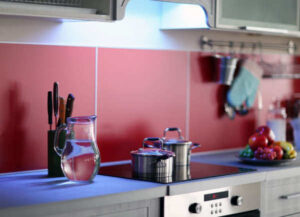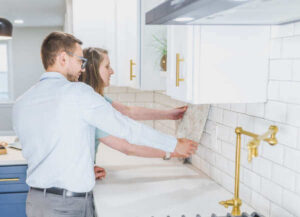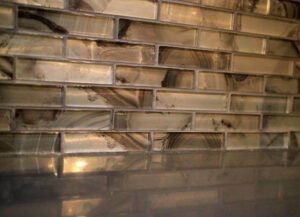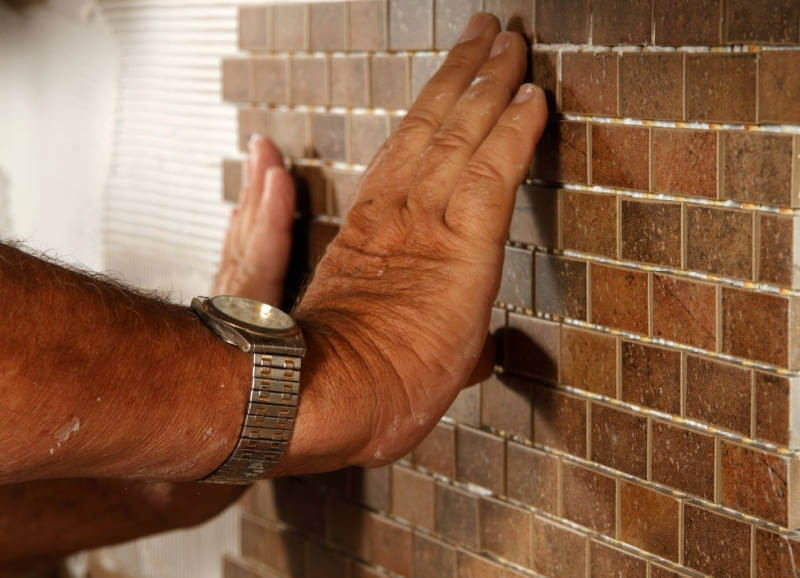Brick backsplashes are a great choice for kitchen backsplash, but they might not appeal to everyone. When this is the case, how do you cover a brick backsplash?
Brick backsplashes can be covered in a simple way by using paint to change the colour and finish of the brick. Otherwise, to cover brick backsplash with other materials, drywall will need to be installed. The other materials, such as tile, are then applied to the drywall to create a new backsplash.
Read on to find out more.
How can a brick backsplash be covered?
The two main ways to cover a brick backsplash involve installing drywall over the brick or removing the bricks altogether. If you want to cover the brick with another backsplash in an easier way, installing drywall is the best way to cover brick backsplashes. Once the drywall is installed, you can use adhesives to create a new backsplash with the material you choose. This material can be tiles or stick-on vinyl backsplash, and more. There are many backsplash options to choose from.
The other way to cover brick backsplash involves removing the bricks themselves. However, this option is not always possible. If the bricks are part of a load-bearing wall, you won’t be able to remove them. This is because proper bricks as part of a backsplash and a wall are usually part of the main support for that area of the house.
If the brick backsplash is made from brick veneer, the veneer can be removed and replaced with a backsplash material of your choosing.
Other ways to cover a brick backsplash include potentially applying self-adhesive tiles over the bricks. But for this to work, the brick surface needs to be as smooth, clean, and even as possible.
The easiest way to change/cover brick backsplash is to paint it. This won’t remove the shape of the bricks but can change the overall appearance. It’s also a good option because you can still have the benefits of a brick backsplash.
Can you put a backsplash over brick?
You can put a backsplash over brick, and for best results, you need to ensure the brick is as smooth as possible. Otherwise, when you apply a backsplash over the brick, it might not seal properly or will have an uneven finish. The best way to put a backsplash over brick is to add a fresh drywall barrier over the bricks first. This immediately takes away the risk of attempting to backsplash a rough and uneven surface.
If the brick backsplash is made from brick veneer, it can be easier to apply a new backsplash over it. Brick veneer is often a lot smoother than proper bricks which is why applying backsplash over veneer could be less difficult. You could even potentially apply tile backsplash over brick veneer because of how smooth the surface typically is.
Can you tile over brick backsplash?
It is possible to tile over a brick backsplash, but this is one of the harder backsplash covers to apply. Brick is a rough, coarse, and uneven surface. If tiles are applied to even a slightly uneven spot, the whole backsplash can be out of line. If parts of the brick stick out in the tiniest way, you can risk cracks in the new tile backsplash.
You will need quality masonry tools to make the brick surface clean and smooth if you want to apply tiles directly over the brick. The best way to put tiles over brick backsplash is to cover the bricks and back of tiles with mortar first. To do so, use a trusty Marshalltown brick trowel. Then press the tile in place, making sure the joints remain even. Once the mortar has set, press the grout into the joints and remove any excess. After about an hour of setting, you can use a sponge to clean the grout haze that settles over the tiles. Once complete, you will have successfully covered a brick backsplash with tiles!
Can brick backsplash be painted?
Brick backsplash can be painted, which is the easiest way to cover a brick backsplash and change its appearance. Make sure you to prime bricks before painting. Bricks are porous and will absorb too much of the paint if you don’t prime them first.
You will need to make sure you buy paint and primers that are specifically meant for brick. The primer will contain added latex, which again helps proper adhesion and fills the pores.
You’ll also need a brick or masonry paint. These again contain latex which will fill in the pores and prevent the paint from simply being absorbed.
Be sure to thoroughly clean and dry the wall before you paint it. If you don’t, any dirt that is on the surface will be forever trapped underneath the paint.
Using painter’s tape is a good idea, too, to cover any area you do not want to paint.
Though it’s a bit more complicated than an ordinary paint job, painting over the brick backsplash is certainly the best way of covering it up.
Can you put glass over brick backsplash?
 You can put a glass panel over a brick backsplash, but there are a few problems you’re going to run into.
You can put a glass panel over a brick backsplash, but there are a few problems you’re going to run into.
First of all, if the edges aren’t sealed or aren’t sealed properly, then dust is going to build up over time on the glass. This will be almost impossible to clean.
Glass, naturally, is also very prone to breaking. Even if it doesn’t shatter completely, one little impact that leaves a crack is all that’s needed to spoil the effect. A harder impact could even shatter the glass, especially if it is not properly fitted.
Given the placement, you’re also likely to end up with big reflections from your kitchen lights on the backsplash. Whether they are under cupboard lights or from the oven, this could very well ruin the effect for many people.
All this said, it is still possible to cover brick backsplash with glass. You will just want to take a few more factors into consideration before choosing a glass coverup.
While you’re researching kitchen backsplashes, check out our article about changing backsplashes without removing tile. For the best quality bricklaying and masonry tools, check out our Paragon Tools shop today!



